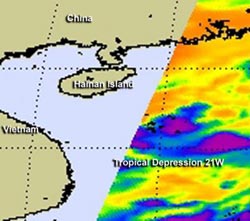NASA observes another tropical depression birth in northwestern Pacific

Infrared imagery from the AIRS instrument aboard NASA's Aqua satellite captured this image of Tropical Depression 21W as a developing low pressure area on Sept. 30. The purple areas indicate the most powerful thunderstorms with coldest cloud top temperatures.<br><br>Credit: NASA/JPL, Ed Olsen<br>
On Monday, Oct. 1 at 1500 UTC (11 a.m. EDT), Tropical Depression 21W (TD21W) had maximum sustained winds near 25 knots. It was centered about300 nautical miles south of Hong Kong, near 17.4 North latitude and 114.8 East longitude. TD21W has tracked northward at 5 knots and is expected to curve to the northwest and west.
On Oct. 1, 2012, infrared imagery from the Atmospheric Infrared Sounder (AIRS) instrument aboard NASA's Aqua satellite shows that the center of circulation is well-defined and the strongest thunderstorms are building in the southeastern quadrant of the storm and wrapping into the center.
The system has been quasi-stationary over the past 12 hours, because it is in a weak steering environment with nothing to push the storm in any direction.
Forecasters at the Joint Typhoon Warning Center expect that Tropical Depression 21W will start moving to the west and approach the central Vietnam coast by Oct. 6 or Oct. 7.
Media Contact
More Information:
http://www.nasa.govAll latest news from the category: Earth Sciences
Earth Sciences (also referred to as Geosciences), which deals with basic issues surrounding our planet, plays a vital role in the area of energy and raw materials supply.
Earth Sciences comprises subjects such as geology, geography, geological informatics, paleontology, mineralogy, petrography, crystallography, geophysics, geodesy, glaciology, cartography, photogrammetry, meteorology and seismology, early-warning systems, earthquake research and polar research.
Newest articles

Sea slugs inspire highly stretchable biomedical sensor
USC Viterbi School of Engineering researcher Hangbo Zhao presents findings on highly stretchable and customizable microneedles for application in fields including neuroscience, tissue engineering, and wearable bioelectronics. The revolution in…

Twisting and binding matter waves with photons in a cavity
Precisely measuring the energy states of individual atoms has been a historical challenge for physicists due to atomic recoil. When an atom interacts with a photon, the atom “recoils” in…

Nanotubes, nanoparticles, and antibodies detect tiny amounts of fentanyl
New sensor is six orders of magnitude more sensitive than the next best thing. A research team at Pitt led by Alexander Star, a chemistry professor in the Kenneth P. Dietrich…





















